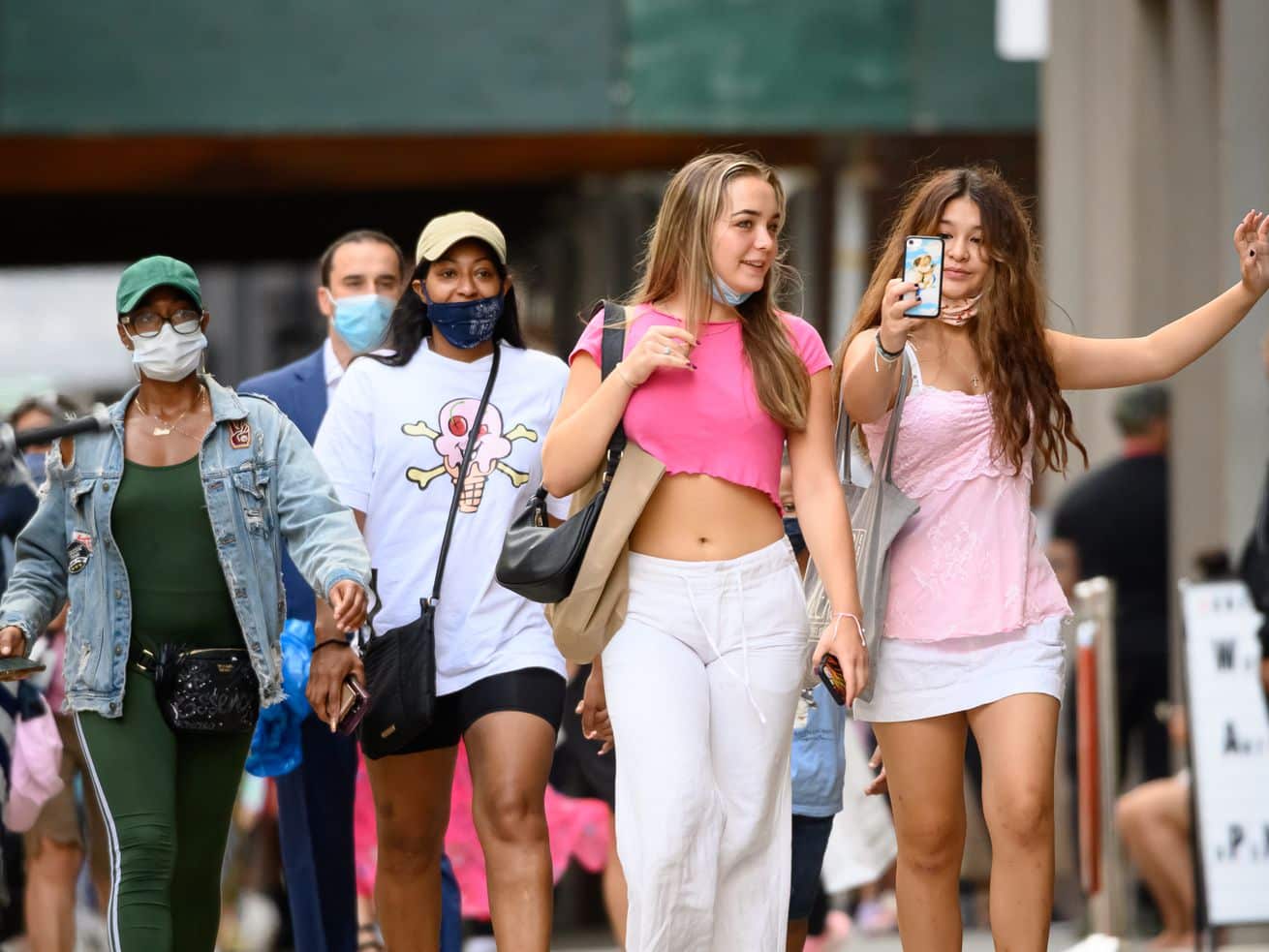Why do we expect teenagers to out-thrift major retailers?
Millions of Americans, specifically those born around or after the year 2000, have never inhabited a world without fast fashion. They became shoppers at the height of its boom: Retailers like ASOS drop at least 5,000 new styles a week, and Shein offers 700 to 1,000 new styles daily. And while these young shoppers are increasingly wary of the evils of fast fashion, they have little room to protest. They buy what’s available, and what’s available is generally fast.
This pace is a relatively modern innovation. Garment production has quietly accelerated to breakneck speeds over the past three decades, easing young and old consumers into thinking of their clothes as disposable. It began in the 1990s, so the story goes, when the founder of Zara spun the fast fashion wheel into motion. Zara abandoned the concept of fashion seasons for the thrill of constant novelty.
A confluence of factors prompted Western designers and retailers — H&M, Forever 21, Gap, to name a few — to follow Zara’s lead in the next decade. Retailers migrated their manufacturing process overseas, where labor was cheaper. Cheaper was better, of course, from a business perspective. It was a period of excess for both consumers and retailers. Profits soared, and the number of garments produced from 2000 to 2014 doubled to 100 billion a year. The dream of “instant fashion” pioneered by Zara became a reality, and things were only about to get faster.
Towards the tail-end of the 2010s, “ultra-fast” fashion brands emerged as viable competitors to the dominant fashion empires of the previous decade. They have names like Boohoo, Fashion Nova, Shein, and Princess Polly, and reached millions of young shoppers through social media, whereas fast fashion’s old guard resided in brick-and-mortar stores.
These retailers have now turned their attention towards Generation Z — the new kids on the block who’ve recently come of spending age. According to Pew Research, members of this demographic were born between the years 1997 and 2010, and grew up under the looming threat of climate change. Gen Z can’t imagine a world without fast fashion because they were born into its heyday. From 2000 to 2014, the average price of clothing declined in spite of inflation. Young people are conditioned to accept low prices as the norm; some even rely on these depressed costs to access trendy clothes. Why pay more when you can buy a brand new T-shirt for $5, a dress for $20, or a pair of jeans for $30?
Yet, marketing research and surveys have found that most young consumers care about sustainability. They are avid thrift store-goers and secondhand shoppers. Gen Z wants similar commitments from the companies they buy from and aren’t afraid to demand it. This has fueled an oft-repeated narrative that Gen Z’s green habits have “killed” or significantly slowed down fast fashion’s global expansion. While fast fashion is a relatively young phenomenon, it’s part of a centuries-old industry that has adjusted to its current pace of growth.
Major retailers are investing in sustainable technologies to bulk up their business portfolios. They’ve pledged to be more sustainable and resourceful in public campaigns. They haven’t, however, pledged to make less. Even if the materials and labor used to produce fashion are marginally better, it does little to offset the clothing consumption cycle Gen Z was born into. In reality, the corporate vice-grip of fast fashion is hard to escape, even for a generation made keenly aware of its environmental implications.
Gen Z certainly isn’t the only group buying from these companies or responsible for their continued success (“Most people in the Global North have worn fast fashion in some capacity in the last two decades,” said Aja Barber, a sustainable fashion writer and critic). They are, however, the first to do so during adolescence as a matter of course. They have to navigate a world in which trends are more accessible than ever. And these questions they face of personal responsibility and overconsumption have remained unanswered and unsolved by older generations.
Sixteen-year-old Maddie Bialek does her best to avoid fast fashion, but she can’t remember a time without plentiful, cheaply-produced clothes. When Bialek was born in 2005, the likes of Zara, Forever 21, and H&M were annually raking in billions of dollars in sales, and proliferating in malls across America and the world. The ultra-fast fashion brands most shoppers Bialek’s age would recognize either were in their infant days or had yet to exist at all. But the speedy groundwork for their later success was firmly established in the aughts.
Bialek is, in many ways, not your typical teenage shopper. She doesn’t buy from resale sites like Depop or Poshmark, and instead mends and crafts her own clothes, usually from secondhand fabrics sourced from local thrift stores. She comes from a family of artists, who instilled within her a do-it-yourself attitude that ultimately led her to reject the premise of fast fashion — that clothes are inherently disposable. “Ever since I’ve started to make and sell my own clothes, I’ve started looking at prices more critically,” Bialek told me. “If I see a new dress for $16, that makes me think someone along that supply chain who made it or transported it might not be paid well or treated fairly.”
/cdn.vox-cdn.com/uploads/chorus_asset/file/22660086/IMG_0517__1_.jpg) Maddie Bialek
Maddie BialekShe added that she “isn’t always perfect,” and could make improvements in other aspects of her life, such as reducing plastic waste. But as a high-schooler, it requires a conscious effort on Bialek’s part to resist buying what everyone else is wearing. Social media might be a democratizing force for fashion, but it’s also an accelerator. Teenagers are a prime consumer market for brands, who are able to target age demographics in social media ads. Plus, the integration of “social commerce” onto platforms like Instagram and TikTok further blurs the lines between scrolling and shopping: Users don’t have to head to a retail site to intentionally browse. Their social media feeds are frequently encouraging them to buy through direct advertisements, influencers, or even their peers.
That’s how Shein, the Chinese ultra-fast fashion retailer, became one of the most recognizable retailers for young female shoppers. The US is the brand’s largest consumer market, due to a successful blend of Instagram and TikTok marketing, low prices, and a trend-forward approach. “Most of my friends buy from Shein,” said Chelsea, a 17-year-old from California, who asked to withhold her last name for privacy reasons. “It’s not my favorite place to shop, but their selection is very trendy and affordable, so if I ever need an outfit for a special event, I tend to look for it there.”
Shein’s advertising strategy is notoriously persistent and ubiquitous across all social platforms. There was a brief period when Chelsea would encounter Shein content wherever she went online. It became impossible to avoid the company. On TikTok, the hashtags #Shein and #SheinHaul boast billions of views, with buyers regularly showing off hundreds of dollars worth of clothes in try-on hauls, essentially serving as free marketing for the brand.
@milenalife.style Which look is your fav Use my code S3milena15 for extra 15% off until 3.31 @shein_official #sheinhaul #springhaul #grwm #commentyourfav #fyp #you
Chelsea occasionally shops secondhand, but she turns to fast fashion sites when she needs a specific item of clothing, like a graduation dress or a halter top. “When you go to a thrift store, you don’t always know what you’re going to find, which can be fun,” she said. “It’s a lot harder to find a specific style you want in a thrift store, especially during the pandemic.”
Resale apps like Depop and Poshmark have popularized secondhand or vintage buying and selling. Yet, their existence isn’t enough to curtail Gen Z’s enthusiasm towards well-known brands — even those with sustainable shortcomings. According to a survey of 7,000 teenagers by the investment firm Piper Sandler, Amazon is one of the most popular online shopping sites teens turn to for clothes and other miscellaneous items. A few ultra-fast fashion retailers like Shein and Princess Polly were also labeled as Gen Z favorites on the survey, competing with established brands like Nike, American Eagle, and Lululemon.
Like many ideas on the internet, the phrase, “There is no ethical consumption under capitalism,” has been boiled into a pithy punchline, stripped of its original anti-capitalist meaning. “People are justifying why they spent hundreds of dollars on new clothes with this phrase they really don’t understand,” explained Shreya Karnik, the 16-year-old cofounder of the publication Voices of Gen Z. “Well, yes, ethical consumption is hard, but that doesn’t mean you should just drop $500 on fast fashion.” For Karnik and her cofounder Saanvi Shetty, the goal is to shop more intentionally, although they’re aware their personal styles might evolve as they grow older.
While the statement’s meaning has been defanged by TikTok teens, it’s rooted in a general truth, especially when it comes to fashion. Fast fashion is, to put it bluntly, the product of a system that prizes profit over workers’ rights and environmental effects. To be clear, most luxury and mall brand companies are no better than fast fashion when it comes to this. (During the onset of the pandemic last spring, retailers like American Eagle and Urban Outfitters cancelled garment orders last-minute and refused to pay workers for their completed labor.)
To be a consumer requires some level of mental separation from the clothing production process. Executives know that sustainability doesn’t scale, at least not quickly enough or to achieve a billion-dollar business model. As a result, clothing supply chains have become so opaque to allow retailers to maximize profit, and it has been decades since a majority of American-designed clothes were actually made in America. Ethical consumption simply isn’t a facet of the modern fashion ecosystem.
‘no ethical consumption under capitalism’ isn’t an excuse for £100+ worth of shein hauls bestie <3
— kim (@kimchrstina) March 27, 2021
Last May, two researchers from Denmark, Nikolas Ronholt and Malthe Overgaard, published a study titled “The Fast Fashion Paradox.” The pair surveyed consumers between the ages of 22 and 25, and completed one-on-one interviews with respondents to understand why the participants kept purchasing fast fashion, despite their own desires to be more sustainable.
“What intrigued us was how the consumers said they cared about sustainability, but that care did not translate into their actual purchasing behavior,” Overgaard told me. “There was a major gap there. It’s become trendy to label yourself as a sustainable consumer, but it’s another thing to see it reflected in your behavior.”
This paradox is particularly evident in the comments section of clothing hauls on TikTok, where a few commentators would urge haulers to shop more sustainably, only for others to defend the purchase. In one Shein haul video with 500,000 likes, a user commented that they were bothered by how Shein packages each item in individual plastic bags. The creator of the video responded in agreement saying, “It is such a waste, I wish they wouldn’t :(“ The response set off a series of comments asking why she bought from Shein if she cared about packaging waste.
@kenzthebenzz i only tried 4 things on lol part 2?? #shein #tryonhaul #NewYearNewMiO #foryou
Ronholt and Overgaard’s research gets at the heart of this responsibility paradox. Who is to blame in this transaction: the lone shopper who purchased hundreds of dollars worth of clothes, or the billion-dollar retailer? Should social media platforms also be held liable? A majority of consumers surveyed expect the retailers to take more sustainable steps, but history has proven that, unless pushed to do so by shoppers, brands are usually slow to act.
Plus, most corporate brands tend to greenwash their efforts with buzzy branding words like “conscious” or “ethical,” while failing to be specific about their goals. In 2018, for example, H&M was criticized by the Norwegian Consumer Authority for “misleading” marketing of its Conscious Collection; the retailer wasn’t specific about what types of “sustainable” materials its clothes were sourced from or what its clear goals were.
“The current situation looks like a deadlock,” said Ronholt. “There’s this duality in response from consumers who felt they could do better, but still wanted more transparency from retailers. Some even suggested political intervention to solve this, like a tax on things that aren’t sustainably produced.”
But even with sustainability hanging in the back of people’s minds, Ronholt added that young consumers have developed a, “I like it, I buy it,” mentality that does little to offset how often they shop. This, of course, is exacerbated by social media’s effects on trend cycles and clothing seasonality: Fast fashion and major retailers no longer rely on the traditional fashion calendar, and instead operate on the premise of “faster is better” to drive sales based on novelty.
Karnik, the co-founder of Voices of Gen Z, admits she likes to browse Shein, even if she’s not planning to buy, in order to stay up-to-date on trends. As a teenager, Karnik’s clothing purchases are usually made under financial constraints. Price, as well as sizing availability, is a major fast fashion appeal for shoppers with budgets or other limitations.
“I’m guilty of looking, and I have like 98 items saved in my cart, although I haven’t bought anything in the past year,” she told me. “I’ve become aware that fast fashion is all about trends, though, so I’m trying to look for staple pieces that will stick with me for a couple of years.”
The most sustainable thing consumers can do, according to fashion critic Barber, is to buy less overall. Her proposed solution doesn’t require everyone to be perfect; it depends on individual efforts to resist novelty and trend cycles, ideally at a large scale.
“There’s a significant correlation between fast fashion, the way we consume clothing, and the rise of social media,” Barber told me. “You have teens saying they don’t want to wear the same outfit twice on social media, and to be honest, that makes me a bit sad.”
The challenge for sustainability advocates is, in Barber’s opinion, education. The number of people working in apparel manufacturing in the US has steadily declined since the 1980s, and less people know firsthand workers that craft their clothes. As a result, it’s become easy to turn a blind eye as to how clothes are constructed and to accept the unsustainable status quo. “In general, we’re losing tradespeople in our society,” Barber said. “If more people knew how much time went into sewing a pin cushion, they could recognize exploitation in a $3 shirt and become better, more informed consumers.”
The core of Barber’s work is deconstructing corporate-driven sustainability and the bevy of products that are marketed to middle- and upper-class people, items that theoretically make them feel better about buying. Most young shoppers can’t afford, for example, handmade clothes. Some proclaim that a sustainable lifestyle feels out of reach because the products are too expensive or don’t come in their sizes.
But according to Barber, sustainability isn’t a product, but a mindset that’s often established out of scarcity and championed by marginalized people, like her mother, who reused almost every plastic container she came across. Low-income people aren’t the consumers keeping fashion corporations afloat. “The most sustainable thing you can do is wear what’s in your closet,” Barber said. “And keep wearing it. When you need to replace something, do so with options that are secondhand.”
As the youngest demographic of consumers, there is an expectation foisted upon Gen Z to reform their shopping habits, sometimes by their peers. And, as Shetty of Voices of Gen Z pointed out, the sustainability movement feels very gendered. Young people’s consumerist tendencies, it seems, are still malleable, and their politics largely progressive. Yet, the task of undoing decades of marketing strategy and environmental degradation shouldn’t solely fall on a generation born within these circumstances. Significant change requires action from a cohort of policymakers, marketers, and retailers — in addition to shoppers, especially those with disposable income.
Author: Terry Nguyen
Read More



